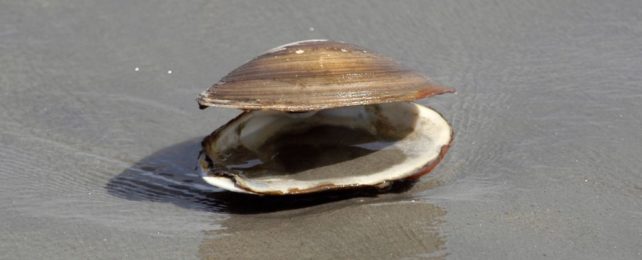Some scientists are becoming clam 'whisperers' to better predict when our planet's climate will tip over into dangerous territory.
A tight-lipped bivalve might sound like an odd creature for researchers to turn their ear to, but as we are coming to learn, clams are exceptional natural historians.
Similar to the rings of a tree, the growth bands on their shells hold crucial information on the environment and how it has changed throughout the years.
Like the lines of a diary, these intricate passages can be teased apart and read by scientists centuries after they were first 'written' down.
In fact, the ancestors of clams have been laying down passages in the mineral calcite for more than five hundred million years, nearly three hundred million years before the dinosaurs showed up, giving us an unprecedented window into past climates.
Now, these ancient archives are issuing a stark warning. A new reading of three bivalve records from the North Icelandic shelf has revealed a potentially dangerous tipping point in Earth's climate.
The findings suggest a shift in our global climate some eight centuries ago was the result of a feedback loop wearing away at the stability of a climate system in the North Atlantic Ocean, driving it into a new, colder state of normal.
The 'Little Ice Age' first started in the 13th century in the North Atlantic and only came to a halt when anthropogenic heating reversed the natural trend.
Scientists still aren't sure what specifically triggered this mini-ice age, but according to the shells of clams, it might have had something to do with an abrupt weakening of subpolar ocean current patterns in the North Atlantic.
Researchers suspect temperatures in the North Atlantic hit a point where sea ice increasingly melted into the Arctic Ocean, diluting seawater with fresh water and weakening ocean currents.
This, in turn, might have led to a reduction in how much heat the currents carried towards the pole, "ultimately reinforcing sea-ice expansion through a positive feedback", the authors write.
The stage was set for a return to an age of snow and ice.
Today, we are headed in the opposite direction, but as other recent research suggests, the North Atlantic might be approaching another worrisome tipping point.
"If rapid loss of Arctic sea-ice, accelerating melting of the Greenland ice sheet, and associated export of freshwater into key convective regions in the North Atlantic continues, a subpolar gyre tipping point might again lead to rapid and long-lasting regional climate change," the authors warn.
Clam shells are only a proxy for past climates in the marine setting, but they are quite reliable.
The ones used in the current study, quahog clams (Arctica islandica), are some of the longest living creatures on planet Earth. In 2013, a deep-sea quahog clam was found that lived to see its 507th year, making it the oldest animal ever found.
Because clams pull oxygen and carbon isotopes out of the water to lay down their calcite shells, the chemical composition of their growth lines can encode annual fluctuations in the marine environment, such as seawater temperature, salinity content, and dissolved carbon.
Relying on these measures, researchers have now found a consistent pattern in long-lived, deep-sea clams that suggests a weakening of the North Atlantic's subpolar currents on two occasions.
The first weakening episode occurred between 1180 and 1260 CE, and the second between 1330 and 1380 CE, not long after some volcanic eruptions (though their role in this turbulent transition is debated).
In the interval between these episodes, shell growth and carbon isotopes in the clams suggest the ecosystem kept pace with the environmental changes. But during the second episode, the authors observed a decline in shell growth starting around 1300 CE.
This suggests that the presence of increased sea ice in the region had possibly disrupted primary production and food supply to the sea bed below, depriving clams of nutrients. After that, the ecosystem never really did return to baseline.
Its resiliency appears to have taken a turn for the worse.
"The evidence presented here for loss of resilience in the subpolar North Atlantic before 1260, together with evidence for the weakening of the potentially bistable, subpolar gyre, indicate that the onset of the [Little Ice Age] may have occurred in response to the subpolar gyre system passing a tipping point," the authors write.
More research is needed to confirm these findings, especially ones that include different climate proxies for comparison. Other studies using a variety of data sources, for instance, also indicate a possible collapse of North Atlantic currents around 1300 CE, tying it to the Little Ice Age as well.
If the North Atlantic is as vulnerable as these studies suggest, this region of the world may be in even more trouble than we thought.
The study was published in Nature Communications.
